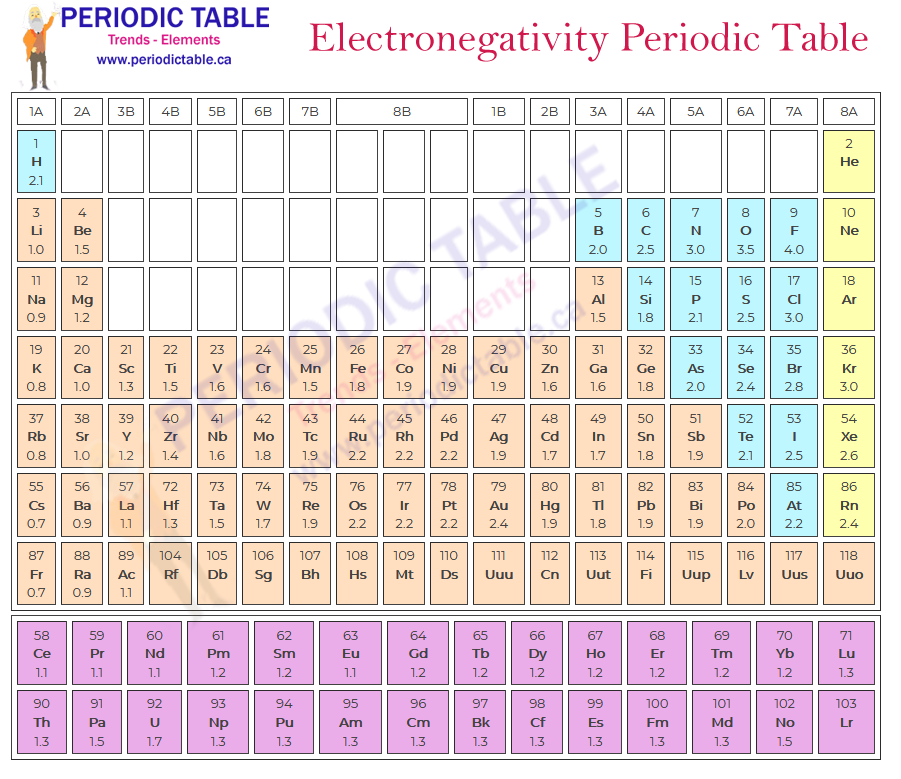

There are exceptions to these trends – for example, the noble gases have full valence electron shells and do not attract electrons.Īpplications of Hard-Soft Acid-Base theoryĬhemistry Question Pack Passage 1 Question 4Ĭhemistry Question Pack Passage 6 Question 32Ĭhemistry Question Pack Passage 7 Question 41 Compared to lithium on the other side of the periodic table, which has fewer protons but similar shells and has a value of 1.0. Fluorine is the most electronegative element due to its relatively high number of protons and a low number of valence shells with a value ion the Pauling scale of 4.0. It decreases down a group due to the increasing protons nuclear charge being canceled out by the increasing number of electron shells that shield the effect of the nuclear charge on the outer electron. The most commonly used method of calculation for electronegativity was proposed by Linus Pauling, commonly referred to as the Pauling scale, with a range from 0.7 to 4.Īs a general trend electronegativity increases across the periodic table from left to right due to the increasing number of protons in the nucleus and the same number of shells. The nuclear charge is important because the more protons an atom has, the more “pull” it will have on negative electrons. On the most basic level, electronegativity is determined by factors such as the nuclear charge and the number/location of other electrons present in the atomic shells. The higher its electronegativity, the more an element attracts electrons. An atom’s electronegativity is affected by both its atomic number and the size of the atom. Excellence in solving chemistry queries in excels and word format.Electronegativity is the tendency of an atom/molecule to attract electrons.Įlectronegativity is a property that describes the tendency of an atom to attract electrons (or electron density) toward itself.
PERIODIC TABLE ELECTRONEGATIVITY FREE
Quality solution with 100% plagiarism free answers.Higher degree holder and experienced experts network.These are avail for subscribed users and they can get advantages anytime. We prepare quality content and notes for Variation of electronegativity in the periodic table topic under chemistry theory and study material. We provide step by step Variation of electronegativity in the periodic table question's answers with 100% plagiarism free content. Live tutors are available for 24x7 hours helping students in their Variation of electronegativity in the periodic table related problems. Pauling and Mulliken values of electronegativities are related as below (Pauling) = 0.34 (Mulliken) - 0.2Įmail based Chemistry assignment help - homework help at ExpertsmindĪre you searching chemistry expert for help with Variation of electronegativity in the periodic table questions? Variation of electronegativity in the periodic table topic is not easier to learn without external help? We at finest service of Chemistry assignment help and chemistry homework help. Where and are electronegativities of the atoms A and B respectively, the factor 0.208 comes from the conversion of kcal to electron volt (1 eV = 23.0 kcal/mole), He described electronegativity difference between the two atoms and then by assigning arbitrary values to few elements ( for example 4.00 to fluorine, 2.5 to carbon and 2.1 to hydrogen), he then calculated electronegativity of the other elements. This is based on the excess of bond energies. (iii) Pauling scale : Pauling scale of electronegativity is the most widely used. Thus where Z is the effective nuclear charge and r is the covalent radius of the atom in Å. (ii) Allred-Rochow scale : Allred and Rochow defined electronegativity as the electrostatic force exerted by the nucleus on the valence electrons. (i) Mulliken's scale : Mulliken regarded electronegativity as the average value of ionization potential and electron affinity of an atom. (3) Electronegativity can be expressed on the following three scales

If an element exhibits various oxidation state, the atom in higher oxidation state will be more negative because of greater attraction for the electron, for example Sn II (1.30) and Sn IV (1.90). This is because of increase in atomic size.

(ii) In a group, electronegativity decreases from top to bottom. The inert gases posses zero electronegativity. Therefore the alkali metals have the lowest value, while the halogens have the highest. This is because of decrease in size and increase in nuclear charge. (i) In the period, electronegativity increases from left to right. The variation of electronegativity in the periodic table


 0 kommentar(er)
0 kommentar(er)
